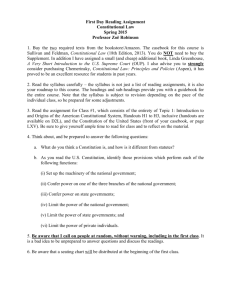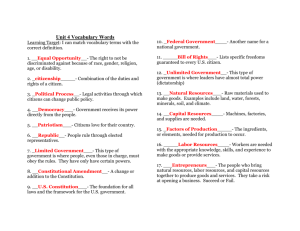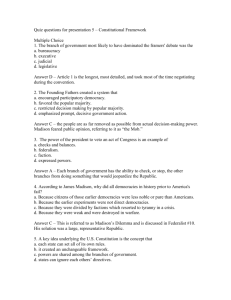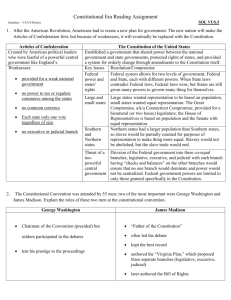AMH 3931 United States Constitution: Origins and Early History
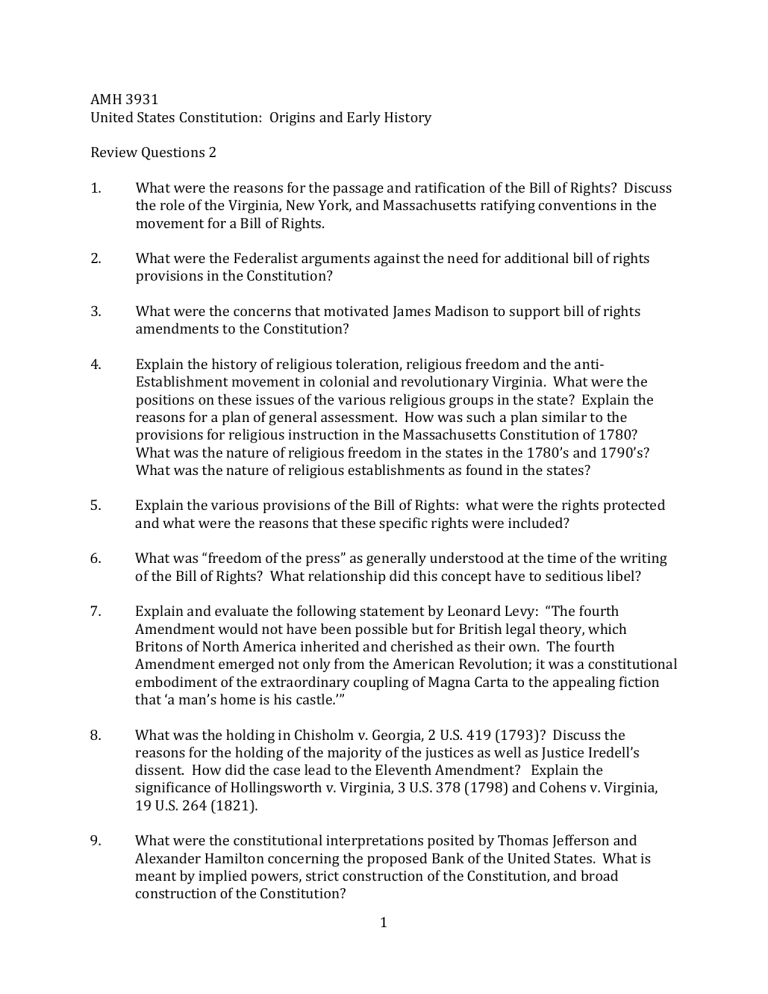
AMH 3931
United States Constitution: Origins and Early History
Review Questions 2
1. What were the reasons for the passage and ratification of the Bill of Rights? Discuss the role of the Virginia, New York, and Massachusetts ratifying conventions in the movement for a Bill of Rights.
2. What were the Federalist arguments against the need for additional bill of rights provisions in the Constitution?
3. What were the concerns that motivated James Madison to support bill of rights amendments to the Constitution?
4.
5. Explain the various provisions of the Bill of Rights: what were the rights protected and what were the reasons that these specific rights were included?
6. What was “freedom of the press” as generally understood at the time of the writing of the Bill of Rights? What relationship did this concept have to seditious libel?
7.
Explain the history of religious toleration, religious freedom and the anti-
Establishment movement in colonial and revolutionary Virginia. What were the positions on these issues of the various religious groups in the state? Explain the reasons for a plan of general assessment. How was such a plan similar to the provisions for religious instruction in the Massachusetts Constitution of 1780?
What was the nature of religious freedom in the states in the 1780’s and 1790’s?
What was the nature of religious establishments as found in the states?
Explain and evaluate the following statement by Leonard Levy: “The fourth
Amendment would not have been possible but for British legal theory, which
Britons of North America inherited and cherished as their own. The fourth
Amendment emerged not only from the American Revolution; it was a constitutional embodiment of the extraordinary coupling of Magna Carta to the appealing fiction that ‘a man’s home is his castle.’”
8. What was the holding in Chisholm v. Georgia, 2 U.S. 419 (1793)? Discuss the reasons for the holding of the majority of the justices as well as Justice Iredell’s dissent. How did the case lead to the Eleventh Amendment? Explain the significance of Hollingsworth v. Virginia, 3 U.S. 378 (1798) and Cohens v. Virginia,
19 U.S. 264 (1821).
9. What were the constitutional interpretations posited by Thomas Jefferson and
Alexander Hamilton concerning the proposed Bank of the United States. What is meant by implied powers, strict construction of the Constitution, and broad construction of the Constitution?
1
10. Explain the importance of Ware v. Hylton, 3 U.S. 199 (1796).
11. Describe and assess the significance of the Virginia and Kentucky Resolutions of
1798 and 1799. What were the constitutional arguments of these resolutions?
What is the theory of nullification enunciated in the Kentucky Resolution of 1798?
12. Explain and evaluate the following statement of Saul Cornell concerning James
Madison’s constitutional interpretations in the 1790’s: “There was no small irony that the man who had done so much to prevent the word ‘expressly’ from being inserted into the Tenth Amendment would come to adopt the strategy favored by
Anti-Federalists as the only means capable of preventing Federalists from subverting the constitution.”
13. Explain the factual background of Marbury v. Madison, 5 U.S. 137 (1803). What was the holding of the court and the reasons for that holding? What is the basis for the doctrine of judicial review? What other important doctrines of constitutional law did the case establish?
14. What were the origins of the 12 th Amendment?
15. How did the views of the Jeffersonian Republicans change over time in relation to constitutional questions? Discuss specifically the Louisiana Purchase, the Embargo
Act, and Second Bank of the United States.
16. Discuss the constitutional significance of the Hartford Convention of December
1814. Did the shift in the Federalist position on states’ rights and strict construction indicate that a continuing dialogue of politics based on constitutional principles and rhetoric had developed?
17. Describe and assess the importance of the Supreme Court decisions in Fletcher v.
Peck, 10 U.S. 87 (1810) and Dartmouth College v. Woodward, 17 U.S. 250 (1819).
18. Describe the views of Chief Justice Marshall in McCulloch v. Maryland, 17 U.S. 316
(1819) concerning the constitutionality of the Second Bank of the United States and of President Andrew Jackson in his veto message concerning the renewal of the bank charter.
19. Describe and assess the importance of the Supreme Court decisions in Gibbons v.
Ogden, 22 U.S. 1 (1824), and Charles River Bridge v. Warren Bridge, 36 U.S. 420
(1837).
20. What is the background for the nullification crisis of 1831-1832? What were the constitutional arguments of the Exposition and Protest? What was President
Jackson’s response? What theories of sovereignty were reflected in the positions of
Jackson and Calhoun? What was Calhoun’s proposal for a concurrent majority?
2
21. How did the development of a two-party system affect constitutional interpretations? Discuss the constitutional views of the Jacksonian Democrats and the Whigs.
22. What is meant by dual federalism, states’ rights, the compact theory of federalism, the departmental theory of constitutional interpretation, and popular sovereignty?
23. What was the factual background to Dred Scott v. Sandford, 60 U.S. 393 (1856)?
Describe the issues in the case and the political background to the decision. What were the opinions of the justices – concentrating on the chief justice’s opinion and the dissenting opinions?
24. What were the theories of secession promulgated in 1860? What were the arguments against such theories? How did the South justify secession? How did
Lincoln respond, and why did the North resist secession?
25. How did the Confederate Constitution differ from that of the United States?
26. What were the constitutional issues that the federal government, and in particular
President Lincoln, faced in the Civil War? Discuss Lincoln’s actions at the outset of the conflict. In addition, specifically discuss the following issues: the legal nature of the war, the problem of internal security and the use of martial law, the suspension of the privilege of the writ of habeas corpus, compulsory military service, and emancipation. Discuss the Vallandigham case and the admission of West Virginia.
27. What was the constitutional significance of the Civil War?
3


